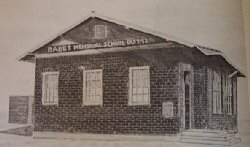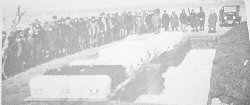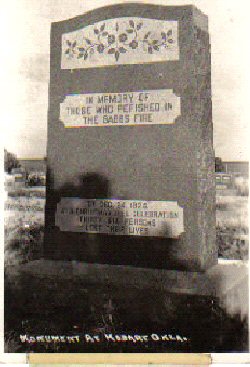 |
Babbs Switch Fire |
 |
 |
Babbs Switch Fire |
 |

Santa Claus arrived on time to the accompaniment of jingling bells and “Ho-Ho-Ho’s”. He began to give out the gifts under the tree. As he straightened up, the cotton trimming on his coat came into contact with one of the lighted candles and in a moment the scene was turned into a blazing inferno. Everyone rushed for the doors which unfortunately opened inward and caused the panic stricken people to force the door shut instead of open. Added to this, the windows were nailed down and there was no escape for 25 of the people who were virtually cremated. Most of the victims were identified by pieces of jewelry they wore, their dentures or teeth and all were unrecognizable.
The information in this article was gathered from a variety of sources; Oklahoma Historical Society, Hobart Democrat Chief, Daily Oklahoman, and articles of interviews of some survivors.

The Babbs Switch School was freshly painted, with turpentine used for paint thinner, before the Christmas program, December 24, 1924. Repairs had been made to the building following a windstorm in May, 1922 including heavy wire netting over all the windows to prevent vandalism and window breakage. The screens were bolted securely with heavy bolts to the sills.
The night was cold and a light snow had fallen. Some residents had to work late in Hobart with the Christmas Eve rush and were disappointed that they were unable to attend the Christmas program at the school. Mrs. Florence Terry Hill, teacher, had taken a leading roll in planning the evening’s festivities. Dowell Bolding was to play Santa Claus.
About 200 men, women and children crowded into the 26’ x 36’ building, standing against the walls and in the aisles. The Christmas tree and program were on the east side, with the main door on the west side. A small door near the cistern was known only to a few.
The program had been presented and Santa was presenting the gifts from the glistening tree with lighted candles; presents were all around the tree with some on it. As Santa distributed the gifts he reached to take a gift from the tree, he pulled the limb down, took the gift off which released the limb. It swung back, knocking a candle against the cotton and tinsel decorations, which caught fire and spread to the tree. Willing hands rushed forward in the effort to smother the blaze.
With the first blaze the people moved restlessly and some started for the only door. The tree was turned over in the effort to extinguish the fire, but served to spread the fire and wild excitement and terror spread. In two minutes the entire room was on fire. In efforts to escape, people broke the windows, but the heavy wire would not give. The door was jammed with people trying to get out; many were trampled to death before the flames reached them. Spectators who witnessed the inferno said whole families died wrapped in each other’s arms.
Those lined against the north wall and to the right of the door, gained the outside because the door had opened inward. People from other parts of the building only succeeded to jam the door so that it opened only part way. Everyone was terrified, parents screaming for their children inside and outside the building. Only a portion of one screen wire was torn away and one man escaped, Clyde Hudson pulled him through, but did not know who he was.
L.F. Edens was one of the last persons to leave the building alive, after helping many people out and in the process was badly burned himself. Another person pulling people out the door was Andrew Jackson. Lillie Biggers Braun crawled out dragging her doll with her, leaving it on the step of the school. Lillie went back for the doll, but her older sister, Bessie recovered it for her. The doll had lost one of its arms in the escape. Max and Hattie Cizek, children who were badly burned in escaping, ran 2 ¼ miles to their home. Many other heroic men and women worked selflessly and performed many brave deeds through the night in efforts to save lives.
Car radiators had been drained to keep them from freezing while their owners were at the program. When those who were able to drive started for Hobart to get help, many forgot to put water in the radiators, causing a delay when the motors got hot and stops had to be made at homes along the road to get water.
When the first auto load of injured reached Hobart, a general call for aid was sounded and cars rushed from Hobart to the school. In 45 minutes all the injured were returned to Hobart and had received emergency treatment. Before midnight, complete aid had been rendered to all. Every physician in Hobart responded to the call and worked all night. The stores were opened and cots and bedding were placed in the hospitals to take care of the 37 brought there. Mrs. Daisy Rodgers was the telephone operator in Hobart at the time, serving at her station, taking calls and placing calls all over the state and the nation many hours.
Arrangements were made with the Rock Island Railroad to send a special car to Hobart to take the injured to University Hospital in Oklahoma City, staffed with nurses. Only one person rode the car back to Oklahoma City, a young Indian boy, Max Cizek. Meanwhile, horror-stricken families and rescue workers still beat through the charred timbers of the school in search of bodies of missing persons.
The Miles Sanitarium and the Physicians and Surgeons Hospital in Hobart were filled to capacity. More than half of the dead were children; several Babbs Switch families were wiped out completely. L. V. Coffey died with his wife and four children huddled in his arms.
Some of the heroic persons who were at the scene were Tom Goforth, Dow Johnson, Lewis Edens, Claude Bolding, Johnnie Harris, Andrew Jackson, J. Reville, a negro man by the name of Charlie, John Goforth, Clyde Hudson and several unknown others. Several survivors remember Tom Goforth standing up when the fire started and urging everyone to be calm, that everyone was going to be alright. His body was found at almost the same spot where he stood. Survivors could not remember all the nightmare things that happened in the doomed school house during minutes that seemed like hours. One couple who were to be married, Vesta Jackson and Aubrey Coffee, both died in the fire.

Volunteer workers combed the ruins all in night in bitter cold until the last body was recovered. The townspeople held a mass meeting on Christmas Day, which was Thursday, and the community quickly organized itself to meet the emergency. Volunteers dug the graves in the frozen ground. Grief stricken survivors filed past the pitiful collection of human remains at the Gish Funeral Home, which was then in City Hall. The victims were identified by the jewelry they wore, dentures and teeth.
Money came from all over the country since news of the fire was carried in all national newspapers, along with messages of sympathy. Before the finance committee had finished its work, it had accepted $12,803.00; the last $1,600 bought the big red granite marker in the cemetery. Much of the money paid funeral and doctor bills.
Thirty two people lost their lives in the fire and four more died within a few days. Several were not expected to live, but the total death as a result of the fire stood at 36. Twenty persons were buried in the community grave where the large granite marker stands; others were buried in their family’s plots.


A campaign was launched at once by Governor Trapp, the state superintendent and state fire marshall to correct all rural school houses in Oklahoma. As a result all doors had to swing out, use of steel netting was banned on windows of all public buildings, proper use of gasoline lamps were required, use of candles on tress in all public buildings was prohibited, faulty heating was corrected and buildings had to have more than one exit and more windows. Most of the public buildings came under strict safety regulations as a result of the Babbs Fire.
The schools grounds are now a memorial roadside park, with a memorial marker along Highway 183, 5ive miles southeast of Hobart. It reads:
SITE OF THE BABBS SWITCH SCHOOL FIRE On December 24, 1924, 35 people lost their lives while attending a Christmas Party in a one room school house. The fire was started by a candle on the Christmas tree. A school building was built here as a memorial and a model to point the way to safer county schools the nation over. The school was discontinued in 1943, was dismantled and sold. IN MEMORY OF W. T. Curtis, Mrs. W. T. Curtis, Edna Curtis, Franies Curtis, T. C. Coffey, Mrs. T. C. Coffey, A. M. Coffey, Ethel Coffey, Maudie Coffey, Orley Coffey, Dow Bolding, Maggie Bolding, Edward Bolding, William Biggers, Walter Biggers, John Duke, John Hebensperger, Mrs. Rhoda Bradshaw, Mattie Mae Bryan, Earnest Peterson, Obil Peck, Ciryl Peck, Paul Peck, Vesta Johnson, Alice Noah, Lee Reville, Lillie Edna Reville, J. T. Goforth, Jaunita Stphenson, Mary Jaunita Stephenson, Gladys Clements, Mary Lois Clements, Mrs. Isabell McNutt, Mrs. Florence (Terry) Hill |
Read a few of the articles that were in the Oklahoma City Times , December 26, 1924 issue regarding the fire.
The Coffey Family, early pioneers and fire victims.
This information compiled, prepared and submitted to
this site by Ethel Taylor and remains the property of the submitter
NOTICE: Ethel Taylor grants that this information and data may be used by non-commercial
entities, as long as this message remains on all copied material, for personal
and genealogical research. These electronic pages cannot be reproduced in any
format for profit, can not be copied over to other sites, linked to, or other
presentation without written permission of Ethel Taylor.
Copyright 2005-2006
Web Page 9-12-2006